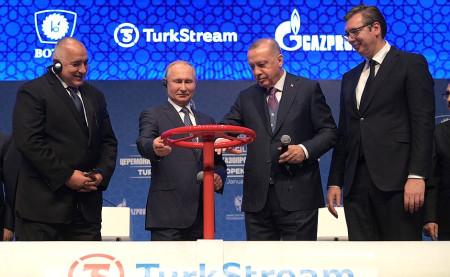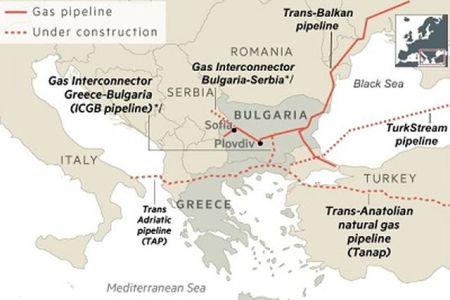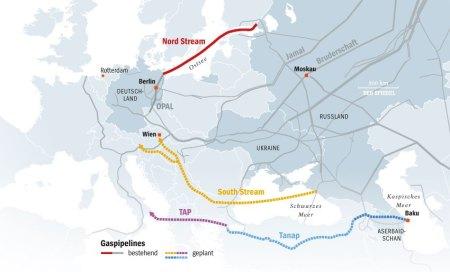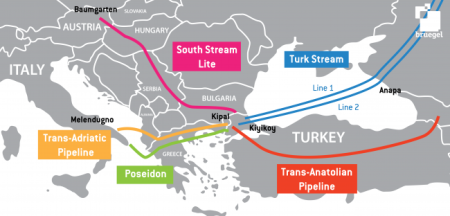 TurkStream (Russian: Турецкий поток; former name: Turkish Stream) is a natural gas pipeline running from Russia to Turkey. Russia–Turkey intergovernmental agreement for TurkStream was signed in October 2016. Construction started in May 2017 and gas deliveries to Bulgaria via the pipeline began on 1st January 2020.
TurkStream (Russian: Турецкий поток; former name: Turkish Stream) is a natural gas pipeline running from Russia to Turkey. Russia–Turkey intergovernmental agreement for TurkStream was signed in October 2016. Construction started in May 2017 and gas deliveries to Bulgaria via the pipeline began on 1st January 2020.
Nord Stream 2 is more related to conflict between the US and Germany as it is about Russian gas coming to Europe, during President Trump’s term in office, relations between Washington and Berlin deteriorated: Instead of importing energy from Russia, US would much preferred that Germany imported from the US. As US made efforts to stop Nord Stream 2, the TurkStream – with extensions in Balkans – attracted hardly any attention from US Congress or those within the EU.
Compared with the controversial Nord Stream 2 from Russia to Germany, Gazprom’s TurkStream natural gas pipeline to Turkey and Southeast Europe has drawn less opposition. TurkStream avoided the fate of Nord Stream 2 probably because it was completed one month before the U.S. sanctions against both pipelines came into effect.
TurkStream starts from Russkaya compressor station near Anapa in Russia’s Krasnodar Region, crossing the Black Sea to the receiving terminal at Kıyıköy. TurkStream has two lines with a total capacity of 31.5 billion m3/a (1.11 trillion cu ft/a) of natural gas. The first line supplies Turkey and the second line transport natural gas further to South East and Central Europe. The costs of the pipeline are estimated to be €11.4 billion.
TurkStream 2 (South Stream Lite)
Gazprom began shipping gas via TurkStream to Bulgaria on 1. January, 2020, replacing supplies via the Trans-Balkan pipeline through Ukraine and Romania.
Now one year later Gazprom has begun supplying gas to Serbia, as well as to Bosnia and Herzegovina, via a new route across Turkey and Bulgaria. Gas from Russia is transmitted by the TurkStream offshore gas pipeline and further across Turkey. It is then brought via Bulgaria’s national gas transmission system to Serbia, where it is distributed among consumers in Serbia and in Bosnia and Herzegovina. Deliveries along this route were made possible through the expansion of existing gas transmission capacities and commissioning of new ones by Bulgartransgaz EAD in Bulgaria and GASTRANS d.o.o. Novi Sad in Serbia.

The new Russian pipeline through the Black Sea to western Turkey was inaugurated on 8. January 2020 in Istanbul, in the presence of Turkish President Recep Tayyip Erdoğan, Russian President Vladimir Putin, Serbian President Aleksandar Vučić, and Bulgarian Prime Minister Boyko Borisov. Credit: kremlin.ru
According to data from S&P Global Platts Analytics, in 2019, Bulgaria received 2.4 billion cubic meters of Russian gas via the Ukraine-Moldova-Romania Trans-Balkan route and transited 4 billion cubic meters more onto Turkey. A year later the volume received via that route fell to almost zero, with TurkStream instead supplying the Bulgarian market. Greece’s take of TurkStream gas in 2020 was up 18% on the 2.41 billion cubic meters of Russian gas it bought the year before delivered by the Trans-Balkan line, while North Macedonia’s imports were also up from the 0.3 billion cubic meters purchased in 2019, S&P Global Platts said on February 8th 2021.
On the 1st of January 2021, Serbia’s President Aleksandar Vučić opened the Serbian section of the European leg of the Turkish Stream in the town of Gospodjinci near Novy Sad. The pipe is 403 km long and its capacity will be almost 14 bcm a year. Serbia now receives most of its gas via the onshore extension of TurkStream at the newly created Kireevo/Zaychar interconnection point on the border with Bulgaria. In January, supplies into Serbia via TurkStream averaged 8 million cu m/d, with flows through the traditional entry point via Hungary down to just 1.5 million cu m/d. Previously, Serbia imported around 10 million cu m/d of Russian gas via Ukraine and Hungary.
As Bulgaria is an EU member, unlike Serbia, Sofia completed its gas investments (TurkStream 2) quietly. In Bulgaria the main contractor was a Saudi company Arkad, which is run by Russians who bought pipes produced in Russia from Russian companies.

TurkStream nominally becomes “Balkan Stream” when it enters Bulgarian / EU territory, from where it is off to Serbia and Hungary. Map: Bulgaria Analytica
Forwards to EU markets
In 2019, Turkey received an average of 11 million cu m/d of Russian gas via the Trans-Balkan pipeline — or a total of 4 Bcm, according to data from S&P Global Platts Analytics. But from the start of 2020, all Russian gas flows to Turkey are carried either by the existing 16 Bcm/year Blue Stream line under the Black Sea or the 15.75 Bcm/year Turkish string of TurkStream.
TurkStream reliably transports Russian gas across the Black Sea to consumers in Turkey and already six European countries: Bulgaria, Greece, North Macedonia, Romania, Serbia, Bosnia and Herzegovina. It managed to bypass Ukraine as a transit state: the Trans-Balkan pipeline from Ukraine to Moldova and Romania has effectively become redundant and will be used in reverse for Russian gas deliveries from TurkStream to the Balkans. And in addition Hungary would like to import up to 6 Bcm/year of gas via TurkStream and its associated onshore infrastructure once a new link up on the border with Serbia is complete, expected in October 2021.
The further extension of the pipeline in South-East and Central European countries are responsibilities of involved countries. For the gas transport both—existing infrastructure and construction of new pipelines—will be used. For Gazprom the preferable option is to export gas from the second line to Bulgaria, Serbia, Hungary, Slovakia, and Austria. For example there is a follow-on project called as the Tesla pipeline, to run from Greece to North Macedonia, Serbia and Hungary, ending at the Baumgarten gas hub in Austria.

An older map showing both Nord Stream and the former South Stream gas transit pipeline project, gives Moscow’s basic idea to go around both Belarus and Ukraine. TurkStream 2 could be described as South Stream Lite. Map: Gazprom
Bottom line
During 2014 Ukraine crisis, gas supplies from Russia lifted again energy issues to the top of the European agenda and led to the creation of the EU Energy Union. As EU developed its energy security strategy, Russia also developed its own strategy, primarily aimed at maintaining its share in the European gas market in the future. In addition Russia has been diverting all its gas transit to Europe away from Ukraine by 2020.
In mid-term – next two decades – EU gas consumption will rise as EU tries to get rid of coal powered and nuclear plants. New sources of gas will came, such as liquified natural gas (LNG) and the Southern Gas Corridor pipeline so Russias’s market share will probably drop; however as need for gas in Europe will rise so the volume of gas from Russia will be the same or rise also. For example Southern Gas Corridor, bringing Azeri gas to southern Europe, has an annual capacity of 18 bcm with half that taken by Turkey and less than 10 bcm available for Europe. In January alone, Gazprom exported 19.4 bcm to Europe, so the extra gas exported in January is almost equal to the annual capacity of the Southern Gas Corridor pipeline. The fact is that Russia has the world’s biggest gas resources and is next door and also that Russia never tried to use gas as a threat – even at the height of the Cold war. For Russia, selling gas to as many customers as possible is both good politics and good economics.
With TurkStream Gazprom skilfully bypassed the EU third energy package, and even better the EU states actually paid for it. Gazprom can now use the most important border points of Bulgarian transit pipelines, without having to pay billions of euros for their construction and without owning the pipes, as Gazprom did not formally engage in the construction of the Turkish Stream’s extensions (South Stream Lite) in Europe. Bulgaria and Serbia made the investments themselves as an expansion of their internal transit network and not publicly as a transit gas pipeline.
TurkStream has now changed the direction in which the Russian gas reaches southeast Europe, and with TurkStream’s onshore expansion, the picture is shifting once again how the Russian gas goes to EU’s market.
Sources i.a: NewEurope , S&PGlobal ,


